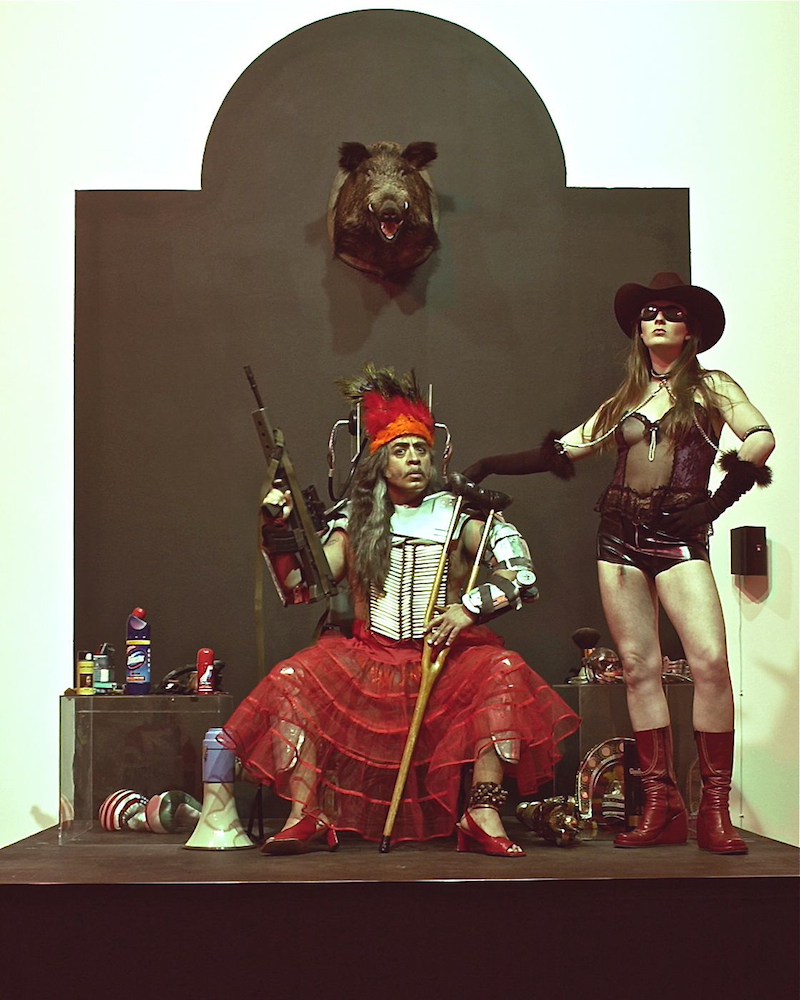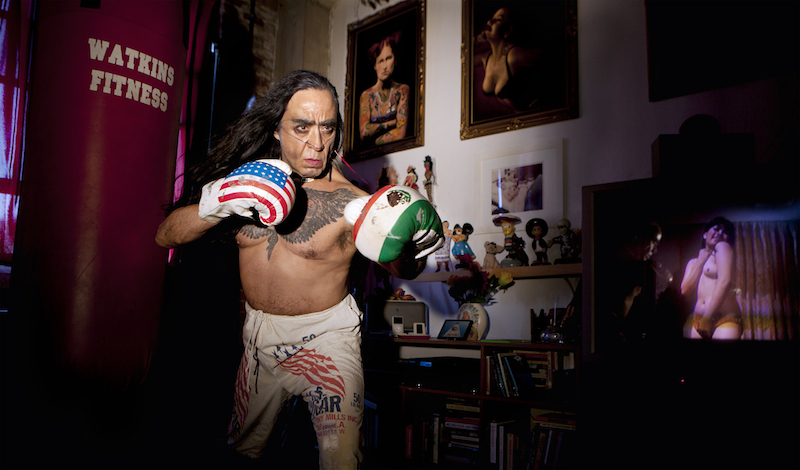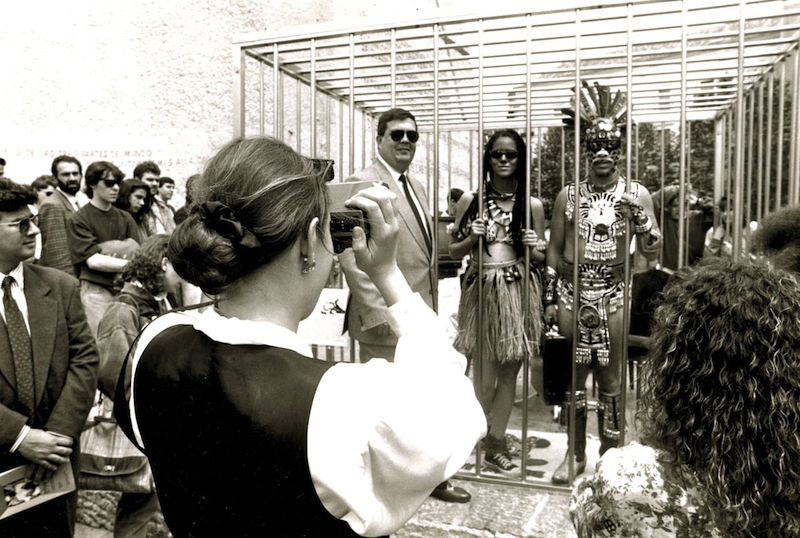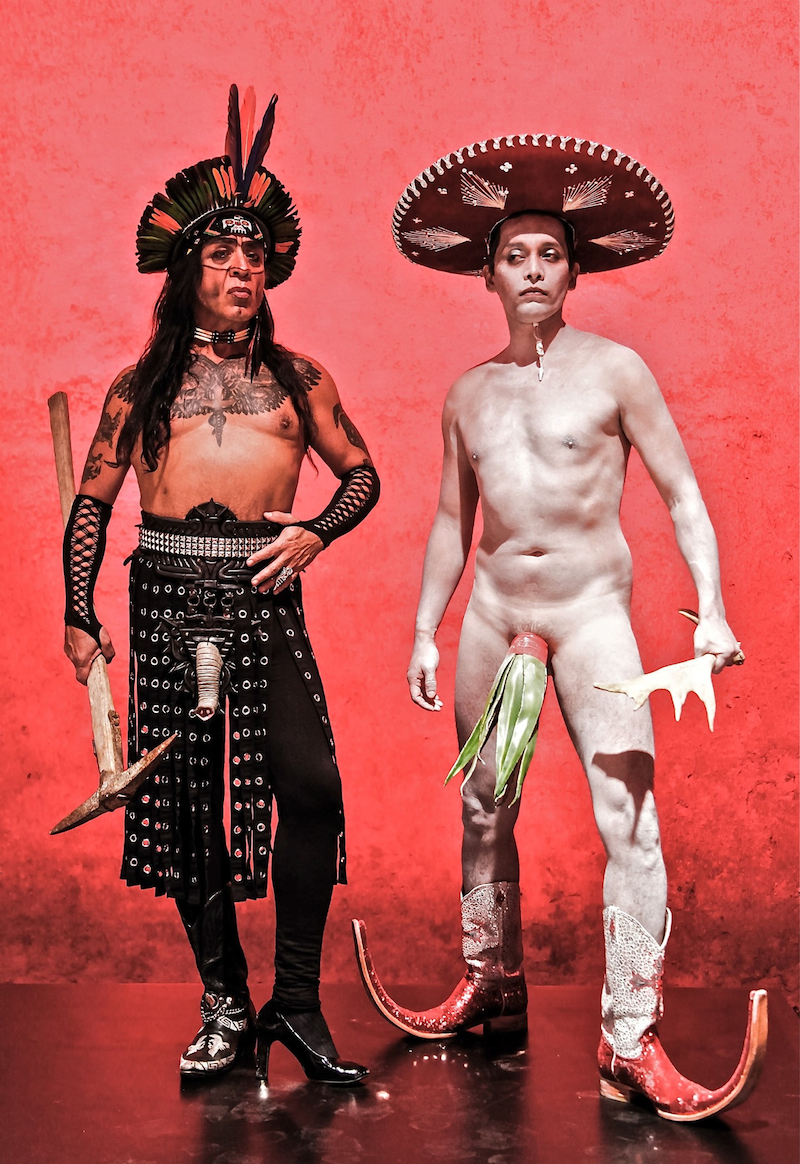
Guillermo Gómez-Peña and Rachel Rogers, Pocha Nostra Royalty, as part of The Museum of Fetishized Identities, Tate Modern, London, 2003; public performance. Courtesy Live Art Development Agency
If we take translate to mean explaining in terms that can be more easily understood, then Guillermo Gómez-Peña—performance artist, writer, collaborator, and educator—resists the facile option of translating for his audience. His performances, poems, and essays often switch rapidly between English, Spanish, French, and other languages, retaining the nuance of each utterance and avoiding the flattening effect of converting one tongue into another. In a recent interview for Art Practical, he stated, “I believe in the sophistication of the human condition. I believe that performance art is such a visceral art form that it allows for multiple points of entry—some are intellectual, but some are spiritual or emotional…I think that misinterpretation and mistranslation are essential contemporary experiences…I feel that the artist doesn’t really give answers.”
Ay, la nostalgia
la nostalgie, yeah, yeah, wow, wow
protects me against the gringos, la migra, the art world…
Qué fuckin’ chingón pasado I had.
My past, pasado, pasadíssimo…
el esss…mog que me vió crecer,
las chavas de la banda, jariosas, tiernísimas…
—performance text from the series The Dangerous Border Game (1995)

Guillermo Gómez-Peña, Not Arthur Cravan, 2012. From the No Portraits photo-performance series. Photo: Jen Cohen
This provocative complexity is the heart of Gómez-Peña’s work, as he investigates issues of race and multiculturalism, gender and language, and borders, religion, and politics. His performances are often over-the-top parodic jabs at the fears and desires that exist between races and cultures, and he appears on stage dressed in cultural drag, the costumes of fetishized south-of-the-border identities, sporting a Mexican wrestler mask or a wide sombrero, a tiger-fur vest or a gold-braided mariachi bolero. But under the camp is a serious desire to explore the realities of intercultural issues in contemporary society.
estimado compañero
del otro lado del espejo
there’s really no danger tonight
estoy completamente disarmado
the only real danger lies
in your inability to understand me
in your unwillingness to trust
—performance text from Border Brujo (1989)

Guillermo Gómez-Peña and Coso Fusco, The Couple in the Cage, 1992; public performance. Photo: Nancy Lyttle
To this end, Gómez-Peña often works with collaborators. In Two Undiscovered Amerindians Visit the West (1992–94), a performance with Coco Fusco, the artists passed themselves off as members of a previously undiscovered Amerindian tribe from an island off the Mexican coast. Traveling to museums, Fusco and Gómez-Peña exhibited themselves in a cage, where they enacted various rituals designed to befuddle art patrons. Gómez-Peña has also worked with the artist Marco Vinicio González on many projects, including an alternative information center called Border, Inc. and several radio programs. Gómez-Peña founded the art collective La Pocha Nostra in San Francisco and has performed with its members in diverse locations, from art centers like New York (Guggenheim Museum), Los Angeles (Los Angeles County Museum of Art), and London (Tate Modern) to remote venues in the Canary Islands and Norway.
Suggested themes for tableaux vivants
The humorous body
The unusual body
The demonized body
The grotesque body
The historicized body
The mythological body
The mediatized body
—pedagogical text from Exercises for Rebel Artists (2011)
In 2005, with La Pocha Nostra, Gómez-Peña opened what he called a “performance summer school” in Oaxaca, Mexico, asking, “How do artists from different countries and races spanning three generations, from every imaginable artistic background, begin to negotiate a common ground?” The work from this ongoing experiment culminated in the 2011 publication of Exercises for Rebel Artists: Radical Performance Pedagogy, which he co-authored with Roberto Sifuentes. Gómez-Peña is the author of nine other books that combine cultural philosophy with performance texts and autobiographical material. In keeping with his methodology, these volumes are hybrids that sidestep strict genre boundaries. Warrior for Gringostroika (1993) contains the essay “From Art-mageddon to Gringostroika: A Manifesto Against Censorship,” an intellectual treatise that is divided into tracks, like a record album. Likewise, The New World Border (1996) intersperses essays and letters with poems and performance texts.
Humble advice for emerging performance artists
1. Work against formulas. If your art becomes too easy to recreate, you are on the wrong path.
—pedagogical text from Exercises for Rebel Artists

Guillermo Gómez-Peña and Saul Garcia Lopez in the moments before the international premiere of the La Pocha Nostra Live Art Laboratory’s Corpo Insurrecto: The Robo-Proletariat at Steirischer Herbst Festival, Austria, 2012. Photo: Wolfgang Silveri
In a 2011 lecture at a symposium hosted by the Hemispheric Institute in New York, Gómez-Peña remarked, “It’s tough to find a useful task for a performance artist in the age of the mainstream bizarre and globalization-gone-wrong. What a strange time to be an artist. In this time and place, what does it mean to be transgressive?” Yet Gómez-Peña’s performance persona is as changeable as his methodology of shifting between languages and media. He continues to employ linguistic code-switching and a tension between seriousness and play in his unceasing investigations into race and culture. He ended the 2011 talk on an optimistic and committed note: “My job as a performance artist is to avoid simplistic definitions…to remain slippery and evanescent.”





Pingback: Guillermo Gómez-Peña: Linguistic Resistance | The Re|view
Pingback: Letter from the (Guest) Editor: Translating Translation | Art21 Magazine
Pingback: Uncaged: Coco Fusco and Planet of the Apes | ART21 Magazine
Pingback: INTRODUCCION: CULTURA Y DISENO II – Notas Cultura & Diseño II